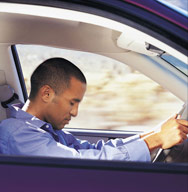Are you a drowsy driver? Many people are! Drowsy driving is one of the leading causes of car crashes in the United States. Just like drugs or alcohol, sleepiness slows reaction time, decreases awareness, and impairs judgment. Just like drugs or alcohol, drowsy driving can be fatal.
Here’s some scary facts about drowsy driving.
- Death rates based on mileage were 3.2 times higher at night than during the day in 2007.
- 37% of drivers surveyed by the National Highway Traffic Safety Administration admitted to falling asleep at the wheel at some point in their driving career.
- 8% admitted doing so in the past six months
- 60% admitted falling asleep while driving on an interstate- type highway with posted speeds of 55 MPH or higher.
The drivers at highest risk are: third shift workers, people that drive a substantial number of miles each day, those with unrecognized sleep disorders, and those prescribed medication with sedatives.
Recognize the symptoms of drowsy driving:
- Eyes closing or going out of focus
- Persistent yawning
- Irritability, restlessness, and impatience
- Wandering or disconnected thoughts
- Inability to remember driving the last few miles
- Drifting between lanes or onto shoulder
- Abnormal speed, tailgating, or failure to obey traffic signs
- Back tension, burning eyes, shallow breathing or inattentiveness
Safety tips to prevent drowsy driving
- Maintain a regular sleep schedule that allows adequate rest.
- When the signs of fatigue begin to show, get off the road. Take a short nap in a well-lit area. Do not simply stop on the side of the road.
- Avoid driving between 12am and 6am
- When planning long trips:
- Share driving responsibilities with a companion
- Begin the trip early in the day
- Keep the temperature cool in the car
- Stop every 100 miles or 2 hours to get out of the car and walk around; exercise helps to combat fatigue
- Stop for light meals and snacks
- Drive with your head up, shoulders back and legs flexed at about a 45 degree angle
Information and recommendations are compiled from sources believed to be reliable. The National Safety Council makes no guarantee as to and assumes no responsibility for the correctness, sufficiency or completeness of such information or recommendations. Other or additional safety measures may be required under particular circumstances.
This information from the National Safety Council.


